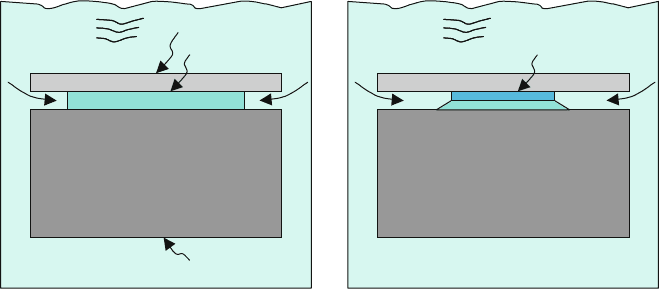Ghodssi R., Lin P., MEMS Materials and Processes Handbook
Подождите немного. Документ загружается.


614 D.W. Burns
Table 8.32 (continued)
Structural
layer/sacrificial layer
Etch rate
(Å/s) Etchant Remarks and references
10 Nickel (Ni)/chromium
(Cr)
350 HCl(38%):H
2
O
1:1
Room temperature; electroplated Ni with Cu seed layer; doesn’t
significantly etch Cu or Ni [538]
11 Nickel (Ni)/oxide
(SiO
2
-PSG)
3300 HF(49%)
undiluted
Room temperature; HF etchant (49 wt%); 1000
◦
C PSG anneal; hexsil
process; electroless nickel sandwiched within doped and undoped
polysilicon; Triton X-100 surfactant added to etchant [539]
12 Nickel (Ni)/oxide
(SiO
2
)
BHF Room temperature; BHF etchant; electroplated nickel through LIGA
PMMA mold; strip Ni seed layer in dilute nitric acid prior; single
mask [439]
13 Nickel (Ni)/photoresist
(PR)
Acetone Room temperature; electroplated nickel; sacrificial copper plating
base; thin photoresist sacrificial layer; thick photoresist plating
mold [540]
14 Nickel (Ni)/Ti HCl(38%):H
2
O
1:6
Room temperature etchant, followed by very dilute HF etch for
removal of titanium sacrificial layer; electroplated nickel through
PMMA mold; sacrificial LIGA (SLIGA); remove underlying
polyimide (PI) with ammonium hydroxide [541–544]
15 Nickel (Ni)/zinc (Zn) 28 NH
4
OH(29%):
H
2
O
2
(30%):NaOH:
H
2
O
10 mL:10 mL:3 g:
100 mL
60–70
◦
C etch temperature; sacrificial LIGA (SLIGA); sputtered Ti/Cu
seed layer; follow with NH
4
OH(29%):H
2
O
2
(30%):H
2
O 100
mL:100 mL:500 mL [545]
16 Nickel–iron
(NiFe)/copper (Cu)
50
◦
C NiFe plating temperature; copper or photoresist sacrificial layer
[536]
17 Nickel–iron (NiFe, iron-
poor)/nickel–iron
(NiFe, iron-rich)
1.4–220 Acetic:H
2
O
1:9
40
◦
C acetic acid etch; pulsed electrolyte agitation for in situ
compositional control; preferentially etches iron-rich layers; low
etch rates without biasing; high etch rates with anodic bias [546]
18 Oxide (SiO
2
)/silicon
(Si), (100)
EDP 120
◦
C etch; thermal oxide cantilevers with Cr/Au metallization and
buried p
++
etch stop [547]

8 MEMS Wet-Etch Processes and Procedures 615
Table 8.32 (continued)
Structural
layer/sacrificial layer
Etch rate
(Å/s) Etchant Remarks and references
19 Oxide (SiO
2
)/silicon
(Si), (100)
∼12 TMAH(25 wt%):
silicic acid:H
2
O
80 mL:16 g:150 mL
Deposited and thermal oxides with embedded aluminum and
polysilicon features from CMOS process; 70
◦
C etch for 24 h; also
etched in XeF
2
[514]
20 Oxide
(SiO
2
)/polysilicon
(Si, poly)
1900 XeF
2
(vapor)
3Torr
Room temperature; XeF
2
vapor etchant; 1000:1 selectivity over
PECVD and thermal SiO
2
; doesn’t significantly etch SiC [519]
21 Parylene C/photoresist
(PR)
550 Acetone
undiluted
Room temperature; parylene C micro-channels; novolak-diazoquinone
positive PR; etches ∼1 mm in 30 min; results are linear with the
square root of time; slows moderately for postbaked resist [548]
22 Polyimide
(PI)/aluminum (Al)
350 H
3
PO
4
(85%):
HNO
3
(70%):Acetic:
H
2
O
Room temperature; PAN etchant; 400
◦
C cure for spin-coated
polyimide; evaporated Al sacrificial layer [549, 550]
23 Polyimide (PI)/oxide
(SiO
2
, PSG)
BHF Room temperature; BHF etchant; 140
◦
C cure for spin-coated
polyimide; PSG sacrificial layer; polyimide hinges for polysilicon
structural layers; patterned apertures in poly for faster etching [551]
24 Polyimide
(PI)/photoresist (PR)
Heat 450
◦
C; thermal decomposition (dry release) of negative-acting
polynorbornene (Avatrel 2000P); also SiO
2
-PECVD structural layer
[552]
25 Silicon (a-SI, amor-
phous)/aluminum
(Al)
H
3
PO
4
(85%):
HNO
3
(70%):Acetic:
H
2
O
8:1:1:5
Room temperature; PAN etchant; 415
◦
C amorphous silicon anneal;
PAN etchant at 55
◦
C; evaporated aluminum sacrificial layer [553]
26 Silicon (Si)/silicon (Si) HF(49%):
HNO
3
(70%):
Acetic
1:3:8
Room temperature; HNA etchant; 335–660
◦
C bond to 7740 glass;
dissolved wafer process; high (1:3:8) or low (EDP) doped substrate
removal; leave low-doped (1:3:8) or highly doped (EDP) features
on glass [554, 555]

616 D.W. Burns
Table 8.32 (continued)
Structural
layer/sacrificial layer
Etch rate
(Å/s) Etchant Remarks and references
27 Silicon (Si)/silicon (Si),
porous
KOH:H
2
O
10 g:1000 mL
Room temperature; KOH etchant (1 wt%); mask with Au, NiCr,
poly-Si (restrictions), PR (limited), Si
3
N
4
,SiO
2
(limited), SiC; also
polysilicon or nitride-encapsulated structures [556–559]
28 Silicon carbide
(SiC)/polyimide (PI)
670 O
2
plasma Dry etch; 400
◦
C for PECVD SiC deposition; also SiO
2
and Al
structural layers on polyimide sacrificial layer [408]
29 Silicon–germanium
(SiGe,
poly)/germanium
(Ge, poly)
50–85 H
2
O
2
(30%)
undiluted
90
◦
C; etch rate varies with doping level; doesn’t significantly etch Si
or Si
x
Ge
1–x
with x >0.4 [560]
30 Silicon nitride
(Si
3
N
4
)/aluminum
(Al)
∼35 H
3
PO
4
(85%):
HNO
3
(70%):Acetic:
H
2
O
16:1:1:2
50
◦
C; PAN etchant; PECVD silicon nitride; evaporated aluminum
sacrificial layer; through KOH-etched backside cavities [561]
31 Silicon nitride
(Si
3
N
4
)/silicon (Si,
porous)
KOH:H
2
O
10 g:1000 mL
Room temperature; KOH etchant (1 wt%); auxiliary sacrificial layer to
expose oxide sacrificial layer from wafer backside [562]
32 SU-8 (PR)/oxide (SiO2,
SOG)
HF(49%):H
2
O
1:1
Room temperature; DI water rinse [563]
33 SU-8 (PR)/SU-8 (PR) 330 PGMEA Room temperature; 110
◦
C postbake of SU-8; unexposed lower SU-8
layer dissolves away; Mg mask layer between SU-8 layers; pattern
Mg with HCl; doesn’t significantly etch Cr/Au; also SOG or
SiO
2
(PECVD) as sacrificial layers [564]
34 Titanium (Ti)/gold (Au) Ammonium iodide,
iodine, and
alcohol
Room temperature; deposited titanium; deposited gold sacrificial layer
[565]
35 Tungsten (W)/oxide
(SiO
2
,LTO)
HF(49%):
NH
4
F(40%) 1:6
Room temperature; 580
◦
C selective CVD tungsten deposition;
SiO
2
(LTO) sacrificial layer [566, 567]

8 MEMS Wet-Etch Processes and Procedures 617
8.7.4 Etch Accelerator Layers for Enhanced Sacrificial Layer
Removal
Etch accelerator layers allow an etchant to rapidly etch laterally along a relatively
thin portion of a sacrificial layer, while etching the majority of the sacrificial layer
more slowly yet with an effective etch distance less than the thickness of the sacrifi-
cial layer so that the etch time is determined predominantly by the lateral etch rate of
the accelerator layer. Ion-implanted thermal oxides with argon-implanted dosages in
excess of 1 × 10
13
cm
−2
or phosphorus-doped glass with argon-implanted dosages
in excess of 1 ×10
14
cm
−2
have been shown to accelerate the lateral etch and cause
an angular sidewall taper to form [568]. Similar effects have been observed for
lateral etching of ion-implanted polysilicon and silicon nitride [569]. As the accel-
erator layer is removed, the etchant is exposed to the bulk of the sacrificial layer
and can remove it relatively quickly, as illustrated in Fig. 8.17. Boron, phospho-
rus, or arsenic-doped glasses etch much faster in HF and buffered HF solutions
for most levels of dopant, dopant type, and HF concentration [570]. Bilaminate
layers of doped and undoped oxides have also been shown to favorably acceler-
ate the lateral etch rate [571]. Other material configurations such as a polysilicon
layer on top of a single crystal substrate allows an anisotropic etchant to laterally
remove the polysilicon and anisotropically remove portions of the substrate under
the polysilicon regions [572]. Table 8.33 lists some sacrificial etch accelerator layers
and removal recipes.
a)
Etchant
Structural Layer
Sacrificial Layer
Substrate
b)
Etch Accelerator
Layer
Etchant
a)
Etchant
Structural Layer
Sacrificial Layer
Substrate
a)
Etchant
Structural Layer
Sacrificial Layer
Substrate
b)
Etch Accelerator
Layer
Etchant
b)
Etch Accelerator
Layer
Etchant
Fig. 8.17 Sacrificial etch accelerator layers allow a structure to be undercut rapidly. The sacrificial
layer is structurally altered or augmented with a fast-etching layer so that the lateral etch rate of
the sacrificial layer is effectively enhanced. (a) Lateral etching without an accelerator layer, and
(b) lateral etching with an accelerator layer

618 D.W. Burns
Table 8.33 Sacrificial etch accelerator layers and removal processes
Structural
layer/sacrificial layer
Etch rate
(Å/s) Etchant Remarks and references
1 Oxide (SiO
2
,
implanted)/oxide
(SiO
2
,thermal)
25/17 HF(49%):
NH
4
F(40%)
1:7
25
◦
C; BHF etchant (7:1); 3 × 10
13
cm
−2
Ar implant at 50 keV;
enhancement increases to 4.8 for >1 × 10
14
cm
−2
Ar at 50 keV or
< 1 × 10
15
cm
−2
As at 80 keV [568, 569]
2 Oxide (SiO
2
, PSG,
implanted)/oxide
(SiO
2
, PSG)
105/65 HF(49%):
NH
4
F(40%)
1:7
25
◦
C; BHF etchant (7:1); annealed PSG(7 wt%); 1 × 10
14
cm
−2
Ar
implant at 50 keV [568]
3 Silicon nitride
(Si
3
N
4
,
implanted)/silicon
nitride (Si
3
N
4
)
5.2:1 H
3
PO
4
(85%)
undiluted
160
◦
C; 1 × 10
16
cm
−2
As implant at 80 keV [569]
4 Silicon (Si, poly,
implanted)/polysilicon
(Si, poly)
2.6:1 HF(49%):
HNO
3
(70%):H
2
O
3:100:4
Room temperature; HNW etchant; 1 × 10
16
cm
−2
Ar at 50 keV or
1 × 10
16
cm
−2
As at 80 keV [569]
5 Oxide (SiO
2
,
BSG)/oxide
(SiO
2
, CVD)
12/1.7 HF(49%):
NH
4
F(40%):H
2
O
1:10:100
26
◦
C; dilute BHF etchant; annealed BSG(30 mol% B
2
O
3
); selectivity
increases with lower BHF concentration and decreases with higher
BHF concentration [570]
6 Oxide
(SiO
2
-PSG)/oxide
(SiO
2
, CVD)
43/4 HF(49%):
NH
4
F(40%):H
2
O
1:10:33
26
◦
C; dilute BHF etchant; annealed PSG(8.2 mol% P
2
O
5
)[570]
7 Oxide (SiO
2
-
ASG)/oxide
(SiO
2
, CVD)
23/13 HF(49%):
NH
4
F(40%)
1:10
26
◦
C; BHF etchant (10:1); annealed ASG(4.8 mol% As
2
O
3
)[570]
8 Oxide (SiO
2
-
CVD)/oxide
(SiO
2
,thermal)
90/17 HF(49%):
NH
4
F(40%)
1:6
25
◦
C; BHF etchant (6:1); enhancement reduces from 5.3:1 to 3.7:1
with 625
◦
C anneal and 2:1 with 800
◦
C anneal [571]
9 Silicon nitride
(Si
3
N
4
)/polysilicon
(Si, poly) and
Si(100)
KOH:H
2
O
540 g:1000 mL
∼850
◦
C silicon nitride deposition; Si(100) sacrificial layer;
polysilicon accelerator layer; KOH etchant (35 wt%)at 80
◦
C[572]
8 MEMS Wet-Etch Processes and Procedures 619
8.7.5 Rinse Liquid Removal and Antistiction Coatings
Undercutting of structural layers by wet-chemical removal of thin-film sacrificial
layers presents a special dilemma: how to remove the freestanding structures from
the rinse liquid without causing them to break or stick. Rinsing the etchant and dry-
ing the freestanding microstructures can prove surprisingly difficult, in part because
of the relative magnitude of surface tension and capillary forces that develop
between the structural features and the substrate as the etchant or rinse liquid dries
[573, 574]. Blow-drying and stiction effects during drying can be detrimental to
the process yield. High-stiffness devices such as low- and medium-aspect ratio
beams, plates, and shells provide enough rigidity to overcome capillary forces and
surface-tension effects as the rinse liquid is spun off and the devices are blow-dried.
Low-stiffness devices common in MEMS sensors and actuators may have sidewall
or bottom surfaces that come in contact with other features or the substrate as the
last of the rinse liquid evaporates from around the structures. This temporary contact
may become permanent, causing yield loss.
Devices in operation may be subjected to high forces that cause contact between
surfaces and subsequent sticking. In-use stiction concerns may best be resolved with
appropriate design improvements such as increased structural stiffness or limited
contact area, or with the application of suitable thin coatings around the microstruc-
ture. Release stiction also may be resolved through design by establishing and
adhering to minimum structural stiffness design rules. Reductions in stiction may
be obtained by limiting mechanical contact area during drying or while in use with
structural features such as small detents, protrusions, or dimples in the structural
layer or enhanced surface roughness to limit the exposed surface area in contact
with the substrate, allowing the innate stiffness of the structural layer to restore the
freestanding features after contact is made.
The general rinsing sequence can be augmented for devices with low stiffness
elements: (1) a low surface-tension final rinse liquid such as alcohol may be useful
in marginal situations; (2) the exposed surfaces may be chemically altered to reduce
the surface tension effects by roughening or by altering their phobicity; (3) the final
rinse liquid may be extracted in a nonliquid state via freezing and sublimation, or
through critical-point drying; (4) the structures may be coated with an effective, low
surface-tension coating prior to drying; or (5) vapor or dry release processes such as
vapor HF or XeF
2
gas may be adopted for removal of the sacrificial layer that avoid
the use of a liquid altogether.
Freezing and sublimation techniques involve freezing the final rinse liquid such
as water, alcohol–water mixtures, or organic compounds such as cyclohexane or
t-butyl alcohol, and then sublimating the frozen material with a vacuum pump or
with enhanced air flow. Full wafers or single die are transferred quickly from the
final rinse liquid to decant most of the liquid while preventing air drying, and then
placed on a cooling plate or simply pumped down in a chamber to freeze the thin
layer of liquid remaining on the wafer surfaces. Sublimation of the frozen liquid
begins and fractions of an hour to several hours may be needed to complete the
process.
620 D.W. Burns
Critical point drying can be an effective way to remove rinse liquid after sacri-
ficial etching and avoid microstructure release stiction. At the critical point, liquid
and gas phases coexist at the highest possible temperature. Above this critical tem-
perature, no liquid phase exists. Carbon dioxide with a critical point of 7.38 MPa
at 31.1
◦
C is more suitable than water with a critical point of 22.1 MPa and 374
◦
C
[575]. Critical point drying with carbon dioxide may be used to r emove final rinse
liquid such as isopropyl alcohol or methanol [576, 577]. While under pressure at
room temperature, the rinse liquid is methodically replaced with liquid CO
2
and
then the chamber is elevated in pressure and temperature above the CO
2
critical
point. The CO
2
is then vented while maintaining the temperature above the crit-
ical temperature to allow the devices to be dried without ever crossing a phase
boundary.
Very thin layers of low surface-tension material may be deposited on exposed
surfaces to reduce or prevent release stiction, such as self-assembled monolayers
(SAM). These coatings can also reduce operational stiction, and may be applied
as part of the rinsing sequence or in a later step after the devices have been
dried.
Table 8.34 shows a succession of rinse-liquid removal processes that target
polysilicon microstructures on silicon substrates with or without a buffer or iso-
lation layer. The solvent-intensive processes may be more suitable for single-die
release, although several of the processes have been scaled for wafer-level pro-
cesses. The techniques are extendable to other structural and sacrificial material
combinations.
8.7.6 Examples: Sacrificial Layer Removal and Structural
Layer Release
8.7.6.1 Example 1: Fine-Grain Stress-Controlled Polysilicon with an Oxide
Sacrificial Layer
A2.0µm-thick fine-grain stress-controlled polysilicon film is deposited on a
1.5 µm-thick thermally grown oxide and annealed. The polysilicon is patterned and
etched, then undercut with concentrated HF etchant (49%) for 10 min to undercut
about 10 µm on each side of the patterned polysilicon, resulting in freestanding
cantilevered and doubly supported sections of polysilicon that are 20 µm wide. The
HF is removed with a dilution rinse where DI water is flushed into the etch beaker
to dilute the etchant without removing the wafer. The wafer is dried with a nitrogen
gun, and high-stiffness beams and shells become freestanding.
8.7.6.2 Example 2: Poly-SiGe on a Patterned Oxide/Nitride Laminate
A1.0µm layer of borophosphosilicate glass (BPSG) i s deposited on a 500 Å thick
layer of silicon nitride on a silicon wafer. The bilaminate layer is patterned and
etched to expose anchor points. A 2.0 µm-thick SiGe polysilicon film is deposited

8 MEMS Wet-Etch Processes and Procedures 621
Table 8.34 Rinse liquid removal processes
Material
Removal
rate (Å/s) Rinse liquid Remarks and references
1 Polysilicon
microstructures on
Si
H
2
O Freeze-sublimation drying; also sublimation drying; dilution rinse, set
wafer horizontally with rinse water on top into roughing pump
vacuum system; self-freezes when pumping; sublimates free with
time; can be destructive due to water expansion when freezing; may
need thermal isolation [578]
2 Polysilicon
microstructures on
Si
H
2
O:Methanol Freeze-sublimation drying; set wafer horizontally with rinse solution
on top into roughing pump vacuum system; self-freezes when
pumping; sublimates free with time; less destructive t han water;
may need thermal isolation [579]
3 Polysilicon
microstructures on
Si
t-Butyl alcohol t-Butyl alcohol freeze-sublimation drying; displace rinse water with
IPA, transfer rapidly to liquid t-butyl alcohol (>26
◦
C), freeze in
refrigerator, then sublimate in vacuum pumping system [580]
4 Polysilicon
microstructures on
Si
Cyclohexane Freeze-sublimation drying; dilution DI water rinse, add IPA and
transfer wafer to IPA bath, transfer to cyclohexane bath, freeze
(<5
◦
C) on Peltier cooler, then sublimate with N
2
gas flow [581]
5 Polysilicon
microstructures on
Si
Carbon dioxide
(CO
2
)
Supercritical CO
2
drying; dilution rinse, transfer to methanol bath,
replace methanol with liquid CO
2
(∼17
◦
Cat∼800 psi), increase
chamber pressure above 1350 psi as temperature is brought above
40
◦
C; retain temperature while venting CO
2
[576, 582]
6 Polysilicon
microstructures on
Si
Octadecyltrichloro-
silane
(OTS)
Self-assembled monolayer (SAM) coating and drying; 0.02 M
solution in 5:1 hexadecane:CCl
4
mixture; HF etch, 15-min dilution
rinse, NH
4
OH:H
2
O
2
:H
2
O 1:1:5 for 5 min at 70
◦
C, 10-min DI water
rinse, 5-min methanol bath, 15-min methanol, 5-min CCl
4
bath,
15-min CCl
4
, 5-min OTS solution, 5-min CCl
4
, 15-min CCl
4
,
5-min methanol, 15-min methanol, then air dry with IR lamp; stable
to 225
◦
C[583, 584]

622 D.W. Burns
Table 8.34 (continued)
Material
Removal
rate (Å/s) Rinse liquid Remarks and references
7 Polysilicon
microstructures on
Si
Perfluorodecyltri-
chlorosilane
(FDTS)
Self-assembled monolayer (SAM) coating and drying; 0.001 M
solution in iso-octane; HF etch, 10-min DI water rinse, 15-min
H
2
O
2
(30 wt%) soak, 5-min H
2
O rinse, 5-min IPA rinse,
2 × 5 - min iso-octane rinses, 10-min FDTS solution in N
2
drybox,
2 × 5 - min iso-octane rinses, 2 × 5 - min IPA rinses, 5-min DI
water rinse, air dry; stable to 400
◦
C[585]
8 Polysilicon
microstructures on
Si
Dichlorodimethyl-
silane
(DDMS)
Self-assembled monolayer (SAM) coating and drying; 0.001 M
solution in iso-octane; HF etch, 5 × 2-min DI rinses, 10-min
H
2
O
2
(30 wt%) soak, 1-1/2 min IPA wash and soak, 1-1/2 min
iso-octane wash and soak, 10-min DDMS solution, 2-1/2 min
iso-octane wash and soak, 1-min hot-plate dry, all in N
2
-filled glove
box at room temperature; stable to 400–450
◦
C in air; vapor-phase
variants available [586, 587]
9 Polysilicon
microstructures on
Si
Polydiphenylsiloxane
(PDPS)
470–485
◦
C; WASA (wafer anti-stiction agent) coating;
silanol-terminated PDPS; evacuated N
2
-backfilled box oven; also
octaphenylcyclotetrasiloxane or mix with cyclic diphenylsiloxane;
25–45 min [588]
8 MEMS Wet-Etch Processes and Procedures 623
on the wafer and annealed. Buffered HF(6:1) is used to sacrificially etch the BPSG
layer through an array of 4 µm-square holes in freestanding portions of the SiGe
layer and leave the nitride layer relatively intact. The wafer is placed into successive
beakers of methanol and then into a critical-point dryer (CPD) where the solvent is
displaced with liquid CO
2
under pressure. The pressure and temperature are raised
above the critical point and the chamber is vented while maintaining the temperature
above the critical point temperature, and the structure becomes free standing.
8.7.6.3 Example 3: Silicon Nitride on a Polysilicon Sacrificial Layer
A1.0µm-thick layer of silicon-rich, stress-compensated silicon nitride is deposited
on a rough-textured polysilicon film, patterned, and etched. The underlying polysil-
icon sacrificial layer is removed in a wet etchant comprising sulfuric, nitric, and
acetic acids in a 2:3:2 ratio at room temperature. Standard dump-rinse and spin–dry
procedures are used for the small aspect-ratio structures.
8.7.6.4 Example 4: Aluminum on Photoresist
A2-µm thick layer of aluminum is e-beam evaporated onto a patterned layer of
1-µm thick photoresist. The aluminum is patterned and etched, and the photoresist
is solvent etched in acetone for 10 min to free the 60 µm-wide aluminum structures.
The structures are immersed in a rinse beaker with IPA for 5 min, then carefully
dried with a nitrogen gun.
8.8 Porous Silicon Formation with Wet Chemistry
With the application of suitably applied voltages, current, and in some cases external
light, silicon can be selectively etched into highly porous material using a hydroflu-
oric acid etchant. The transformed material retains its initial crystalline orientation,
along with hydrided surfaces and a spongelike or sometimes fractal pore structure.
The porous silicon can be further oxidized or etched, which can occur quite rapidly
due to the large surface area of the porous material. The porous layer can support
the deposition of additional films such as epitaxially grown silicon as the outer pores
become plugged and provide a surface for further processing [589, 590].
Porous silicon can be formed by chemical staining etchants, although it is gen-
erally formed using dilute mixtures of hydrofluoric acid and either water or alcohol
in an electrochemical etch that is driven with an external power supply. Unmasked
portions of a silicon wafer are electrochemically etched with controllable pore sizes
and depths depending on the dopant type, dopant level, current density, and etchant
concentration, among other factors. Silicon surfaces exposed to the etchant are trans-
formed into porous silicon as the bulk silicon is etched. Prestructured substrates with
pyramidal etch pits or etched detents can cause pore initiation from the pit tip, fol-
lowed by pore formation perpendicular to the wafer surface a distance of several
hundred microns or more with continued application of current. Application of light
